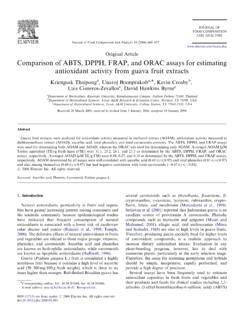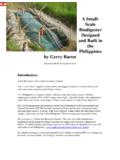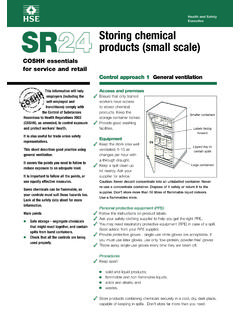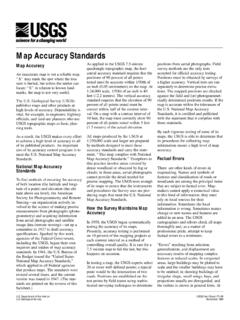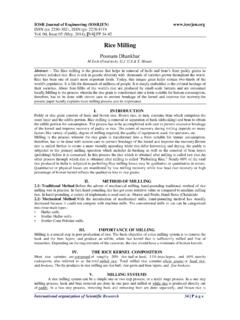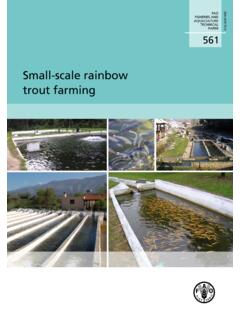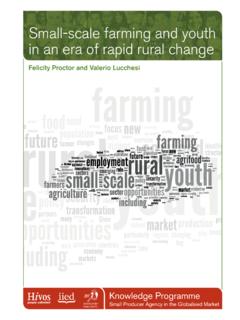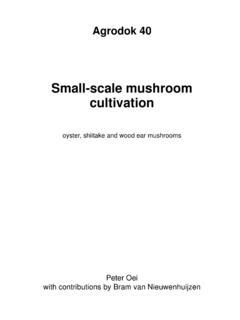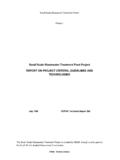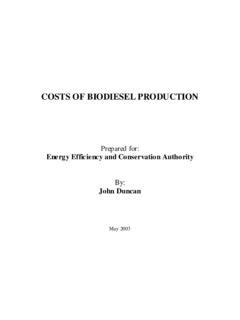Transcription of SMALL-SCALE COFFEE PROCESSING
1 SMALL-SCALE COFFEEPROCESSINGC offee (Coffea Spp)Agricultural and botanical aspectsArabica (Coffea arabica)This is a glossy leafed shrub or small tree. The leaves are relatively small and the flowersfragrant and white. Arabica COFFEE usually receives a premium for its superior flavour andaroma. Arabica is more suited to higher cooler climates eg 600-2000m above sea level and15-20 (Coffea canephora)There are many different Robusta varieties. In general, they can thrive in hotter lowland areaseg below 900m above sea level and over 20 C. Robusta COFFEE is preferred for instant coffeeproduction due to higher soluble solid (Coffea liberica)This is a larger tree with large leaves and berries.
2 It can tolerate hot and wet conditions. Thecoffee produced is bitter. This is preferred in Malaysia and West definition, ' PROCESSING ' does not involve harvesting. However, one cannot produce a goodproduct from badly harvested materials. Correct harvesting techniques could be said to be themost important factor in the production of a high quality final product. Correct harvesting isessential. A good COFFEE cannot be made from poorly harvested COFFEE harvestingThis is the most serious problem with COFFEE harvesting. Under-ripe COFFEE cherries are verydifficult to process and a low quality product is produced. One of the main causes of immatureharvesting is the fear of theft.
3 If the farmer picks it in an immature state, it prevents the thiefstealing coffeeWith over-ripe COFFEE there is a possibility that the cherry will start fermenting which causesdeterioration in harvestingThe COFFEE cherries should be picked when they are bright red all over. At this stage, the beancan be squeezed out from the pulp by applying light pressure between finger and are two ways COFFEE can be processed - dry ('natural') PROCESSING and wet ('fermentedand washed') PROCESSING . In most cases, wet PROCESSING is regarded as producing a higherquality product. However, some areas prefer dry processed COFFEE for its 'fuller' processingThis is the simpler of the two methods and is popular in Brazil to process Robusta COFFEE andin Sri Lanka to process Arabica COFFEE PROCESSING Intermediate Technology Development Group2 DryingThe COFFEE cherries are dried immediately after harvest.
4 This is usually sun drying on a cleandry floor or on mats. The bed depth should be less than 40mm and the cherries should beraked frequently to prevent fermentation or discoloration. However, there are problemsassociated with this method. The most serious problem is dust and dirt blown onto theproduce. Another problem is rainstorms often appear (even in the dry season) with very littlewarning, this can soak the produce very quickly. Finally, labour has to be employed to preventdamage or theft. Sun drying is therefore not DryingFigures 1 and 2 are designs for two solar driers - the solar cabinet drier and the Exell solardrier. The COFFEE should be placed in the trays in the solar drier.
5 The layer of the crop shouldbe no deeper than one inch (3cm) and it is better if the whole tray area is drier should be ready as early in theday as possible so that all possiblesunlight hours are used. The coffeeshould be stirred regularly so that auniform colouration is formed. At night,the crop should be placed in a cool driersIn the wet season solar drying of produceis difficult. Rain is very unpredictable andfrequent. Solar driers will prevent thecoffee getting wet. However, due to thelow level of sunlight, solar drying can takea long time. This can lead to mouldgrowth. An alternative drier is dried cherry is then hulled to removethe pericarp.
6 This can be done by handusing a pestle and mortar or in amechanical huller. The mechanicalhullers usually consist of a steel screw,the pitch of which increases as itapproaches the outlet so removing hulled COFFEE is cleaned processingIn this method the cherry is squeezed in apulping machine or pestle and mortarwhich removes the outer fleshy material(mesocarp and exocarp) leaving a beancovered in mucilage. This mucilage isfermented and dispersed. The bean iswashed and involves the removal of the outer red skin (exocarp) and the white fleshy pulp(mesocarp) and the separation of the pulp and beans. Immature cherries are hard and greenFigure 1: The solar cabinet drierFigure 2: The exell solar drierSmall- scale COFFEE PROCESSING Intermediate Technology Development Group3and very difficult to pulp.
7 If the COFFEE is to be wet processed, correct harvesting is SMALL-SCALE units, the cherries can be pulped in a pestle and mortar, this is very two most common pulpers and most suitable for SMALL-SCALE units are the drum and thedisc pulpersThis involves a rotating drum with apunched sheet surface and adjustablebreast plate between which the coffeecherries are pulped, the pulp and thebeans separated, see Figure 3. Thedistance between the drum and thebreast plate has to be adjusted so thatthe pulp is removed without the beansbeing can be manually operated orattached to a treadle or bicycle. Forlarger scale units, motorised drumpulpers are pulpersThe same concept is involved with thedisc pulper.
8 The only difference is thatrather than the cherries being squeezed between a breast plate and a drum, a disc with aroughened surface is removalThe amorphous gel of mucilage around the bean consists of hemicelluloses, pectic substancesand sugars and is insoluble in water. This can be removed by chemical methods, warm wateror by an 'agua pulper'. However, for SMALL-SCALE units the only feasible method is fermentation. Fermentation involves the beans being placed in plastic buckets or tanks and left until themucilage has been broken down. Natural enzymes in the mucilage and feasts; bacteria in theenvironment work together to break down the COFFEE should be stirred occasionally and every so often a handful of beans should betested by washing them in water.
9 If the mucilage can be washed off and the beans feel grittyrather than slippery, the beans are beans should then be washed immediately as 'off' flavours develop prevent cracking the COFFEE beans should be dried slowly to 10% moisture content (wetbasis). Drying should take place immediately after to prevent 'off' flavours same drying methods can be used for this as for the dry processed drying the COFFEE should be rested for 8 hours in a well ventilated place. The thinparchment around the COFFEE is removed either by hand, in a pestle and mortar or in a hulled COFFEE is cleaned by 3: Separation of pulp and beansSmall- scale COFFEE PROCESSING Intermediate Technology Development Group4 RoastingThe final flavour of the COFFEE is heavily dependant on how the beans are roasted.
10 Roasting is atime temperature dependant process. The roasting temperature needs to be about 200 degree of roast is usually assessed visually. One method is to watch the thin white linebetween the two sides of the bean, when this starts to go brown the COFFEE is ready. Aspreferences vary considerably from region to region, a lot of research will need to be done tofind the locally acceptable degree of beans can be roasted in a saucepan as long as they are continually stirred. A smallimprovement is made by roasting the COFFEE in sand, as this provides a more even roaster will produce a higher quality product. The simplest roaster is basically a tin can witha handle so that it can be rotated slowly over a fire.


